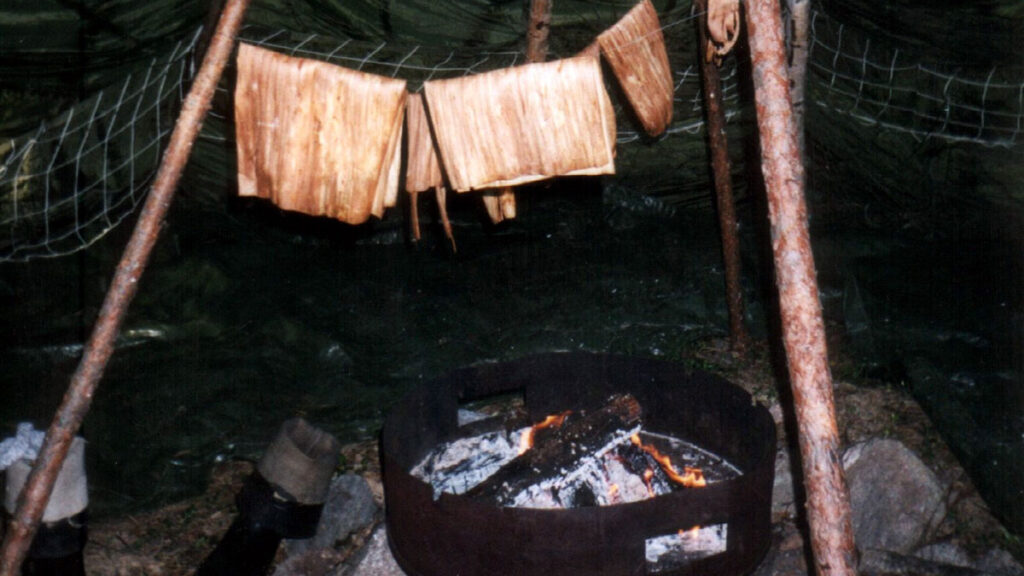
An almost forgotten food from the wild is that which comes from the bark of trees. Once a staple, now it is barely known even as a coarse survival food. I have been slow coming to it even with wild edible plants as a major preoccupation since my teens. An obvious possibility for why tree bark has not been found much in modern cuisine is that it doesn’t taste good. The modern imagination easily responds to the notion of tree bark as food with images of gnawing on trees – not exactly as exciting as fishing, hunting, picking mushrooms, or picking berries. However, perhaps that assumption is wrong. Maybe delicious foods can be prepared from tree bark.
I have in front of me eleven books on wild edibles. At first glance at the table of contents of each book, or the text or index if the plants weren’t listed there, I found nothing in ten of the books related to tree barks as edibles. Euell Gibbons (Stalking the Wild Asparagus) and others discuss Black Walnuts and Hickory for nuts. Lee Allen Peterson (Edible Wild Plants) discusses the leaves of Basswood. Bradford Angier (Field Guide to Edible Wild Plants) discusses the seeds of Maple and, of course, that the sap is boiled into Maple syrup. …And the list goes on of other foods from the trees.O
nly in one, A Naturalists Guide to Cooking with Wild Plants by Connie and Arnold Krochmal, did I find that the authors went on to discuss harvesting and preparing Maple bark. They have a recipe for Maple bark bread that uses, along with other typical ingredients for bread, only ½ cup of all-purpose flour to 2 cups of ground Maple bark. Another recipe for porridge is a typical porridge recipe with only Maple bark (cooked like farina, grits, or oats), along with a suggestion to spread it out to chill and thicken before browning in oil.
There is a long history of making bark bread.
Cuisine and Nutrition
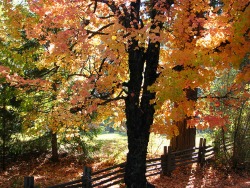
I have not yet tried Maple (Acer spp.) porridge. I have made porridge from Slippery Elm (Ulmus rubra) but only because I have acquired out-of-date stock from herbs stores here-and-there that I worked for. The powdered bark is quite costly to eat like a breakfast cereal. It is sold mostly for home-made lozenges and to add to smoothies. Because the bark is quite mucilaginous, it is a great ingredient for do-it-yourself lozenges for sore or dry throat. I like to always keep some in a convenient storage spot. When I have plenty, I like to cook the powdered Elm bark with Maple syrup (and a little salt) for a real breakfast from the trees. I have not yet attempted to powder the bark itself, though I do intend to. Powdering bark is one of those things that is high up on my list of things to do that I never get around to doing. Again, a survival situation might just re-prioritize that list. The shredded bark is also readily available through commercial sources and is prepared as a cold infusion to produce a thick, moistening drink or ingredient.
Related: Food to Stock for Emergencies
According to Daniel Moerman in Native American Food Plants, Green Ash (Fraxinus pennsylvanica) was cooked by the Ojibwa. Apparently they believe it tastes like eggs. I have chewed it and infused it for “tea”, but will certainly have to try to prepare it like scrambled eggs! I doubt it is all that similar, but I do not doubt that it can be prepared so that it tastes good. Remember, much of foraging is about timing. Not only is bark easier to peel off the tree in the spring (when the sap is flowing), but it also is thick, juicy, and milder tasting than other times of the year. Certainly, timing is important for Ash bark and the others. Though, if starving to death you might eat tree bark even if it wasn’t the ideal harvest season and even if it didn’t taste like eggs.
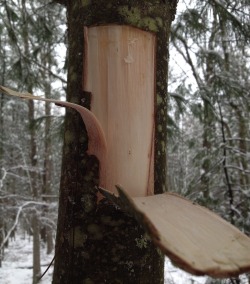
White Pine (Pinus strobus) and other evergreens were vital survival foods for Native Americans in cold areas. Although they often have too much astringency and pitchy consistency to be ideal foods, they also have vitamin C, bioflavonoids, and many important medicinal constituents. It would be interesting, and potentially important in a survival scenario, to look into the nutritional constituents of various barks.
It shouldn’t be too difficult to understand that Pine bark has lots of vitamin C, but what about the macronutrients? Are barks able to provide sufficient sugar, protein, or fat? Sugar seems the most notable macronutrient from bark, but I still wonder how much is there. Certainly, Maple bark can taste remarkably sweet, like Maple syrup. Clearly it has sugar in it. The benefits of bark as a survival food are at least partially illustrated by the Natives formerly feeding Cottonwood (Populus spp.) bark to horses. Certainly, humans have different nutritional requirements than the four-legged grazers, though I still think it says something that the deer, other wild animals, and horses can glean nutrition from bark.
Basswood (American Linden, Tilia americana) is unique as a food tree in that it produces large broad leaves that are edible right off the tree. Young twigs and buds were cooked by Chippewa. By this I would assume that the bark is also mild and edible. However, I turned to Moerman’s book Native American Medicinal Plants to learn that the Cherokee used the bark for diarrhea and the Iroquois used as a diuretic, which has me wondering if the bark is too astringent and drying to use as food.
Of course, many such remedies are mild enough to eat or can be prepared to be more food quality and less medicinal. Generally though, diarrhea remedies are astringent and can cause constipation when not needed for runny stool. Moerman did also report that the Cherokee used during pregnancy for heartburn and weak stomach and bowels. If it was used during pregnancy, I imagine it is mild enough to eat. Basswood bark is now bumped up to the top of the list of wild foods to try out this spring.
Medicinal Uses of Tree Bark
Medicines from tree barks are many. Though this article focuses on edible barks, it would not be complete without mention of medicinal uses. In addition to those already discussed above, the medicinal barks included many categories, such as astringents, cough remedies, blood-moving medicinals, and pain relievers.
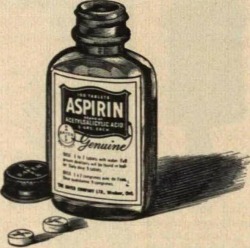
Willow (Salix spp.) was an original source of a well-known medicine known as salicylic acid (named after Willow). Like the drug Aspirin (which is named after Meadowsweet which is currently Filipendula, but formerly Spiraea), Willow is used for pain, to thin the blood, and for fevers. Salicylic acid is commonly used for acne, dandruff, and warts. Poplars (Populus spp.) are closely related to Willow both botanically (though many people confuse Poplars and Birch, or Betula spp.) and medicinally. Poplars have largely fallen out of use in modern times, but formerly were commonly employed as medicinals – the bark used like Willow, and especially the resinous buds used for coughs.
Oaks (Quercus spp.) and many other trees have bitter-tasting astringency. Astringents tone tissue, remove inflammation, and stop discharge. They are important medicines that are indicated for damp, inflamed conditions like diarrhea, rashes, bleeding wounds, and sore throats. Astringents are also used for daily maintenance like washing the face and brushing teeth. In small quantities, they are used to maintain tissue integrity of the gums and digestive system.
Like Cinnamon (Cinnamomum spp.), our Sassafras (Sassafras albidum) is used to stimulate circulation and clean the blood. The bark is delicious as tea, and can be combined with other root beer ingredients like Black Birch (Betula lenta). The leaves of Sassafras are mucilaginous as well as spicy and can be prepared as food. They are used in gumbo. As an aromatic, blood-cleansing medicinal, Sassafras is used to treat skin disorders, arthritis, and to warm up the body. The FDA has a controversial ban on Sassafras and the oil derived from it, safrole.
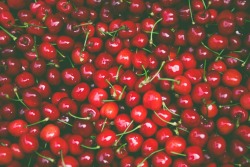
Perhaps one of best-known cough remedies, Cherry Bark (Prunus spp.) has been used for ages. My guess is that Cherry became a standard flavor for cough syrups largely because the bark was a standard medicine for coughs, even though the bark does not exactly taste like the fruit. It does have a distinct Cherry flavor, but even more distinct is the cyanide flavor, especially in the fresh bark. Because of the toxic properties, the use of fresh Cherry bark has been discouraged in the literature. Though, the fresh bark is used medicinally and is significantly stronger than the dried bark.
The dried bark is available through commercial distributions. Especially the wilted leaves have been known to cause poisoning in farm animals, so it seems the toxic properties spike during drying. There are also various ideas about the best time to harvest. Since I am not a chemist, I cannot say much with authority about cyanide content. Consider yourself warned, however.
I encourage you to do your own research (before you find yourself starving or coughing to death in a Cherry forest). Since this is such a valuable medicine I do indeed recommend learning about Cherry bark. In my experience it is a top remedy for coughs and I assume it has many other uses in line with how Peach (Prunus persica) is used in Chinese medicine, which is extensive. If the medicinal barks were not strong-natured and somewhat toxic, they would have been discussed earlier as edible barks. It is precisely because they are strong that they are medicinal.
Black Walnut (Juglans nigra) bark is very medicinal. It is one of the strongest antifungal herbs and is well-known as a remedy for intestinal parasites. The inner bark stains yellow, as do the green hulls and leaves. These parts also give off a distinct aroma that can help with identification and are doubtlessly related to the medicinal virtues. Of course, Black Walnut is also known for its nuts, which are important survival food.

7 comments
Please remember that if you are harvesting bark for food to not completely gird (horizontally encircle) the tree since this will kill it. If you’re also harvesting the wood (firewood, building material, etc.) then this doesn’t matter. As far as I know only the inner barks of some trees are edible! Considering how much effort is needed to harvest enough inner bark to replace the calories burned harvesting it, I would only consider bark as a last-ditch food source! Supposedly, roasting bark makes it more palatable! GLAHP!
My dad was a POW in Germany. He got rations of black bread with sawdust in it. Don’t know if you had heard of stretching bread by using sawdust.
Anyone old enough to remember the old old Grape Nut commercial wit. I’m Yule Gibbins (Sp?) Have you every eaten a pine tree? Many parts are edible.
how much of the bark can be harvested without killing the tree?
In the late 80′ I recall buying plain ordinary white toast bread In major supermarkets, i.e. Publix and they contained sawdust in the list of ingredients
Eating bark was common in medieval Europe during periods of famine
You can use Juniper Berries to make jams and use it in seasoning deer meat. I guess it has some medicinal uses. Also know as the Eastern Red Cedar.